Mike McEnearney's winter whole foods feast
Updated , first published
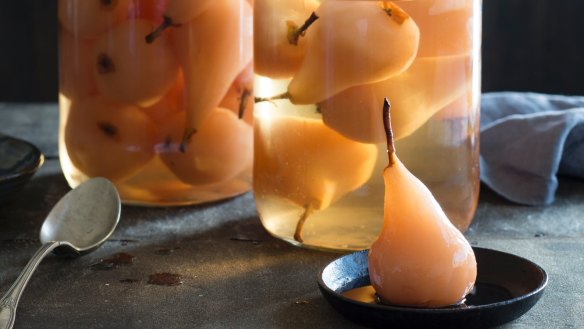
A balanced diet of seasonal, whole foods is nature's medicine, writes the chef in his new book, Real Food by Mike: Seasonal wholefood recipes for wellbeing.
Some people are slow learners. I unashamedly put my hand up to being such a person. It took 20 years of cooking before I had my epiphany, and since that moment it has influenced every day of my life.
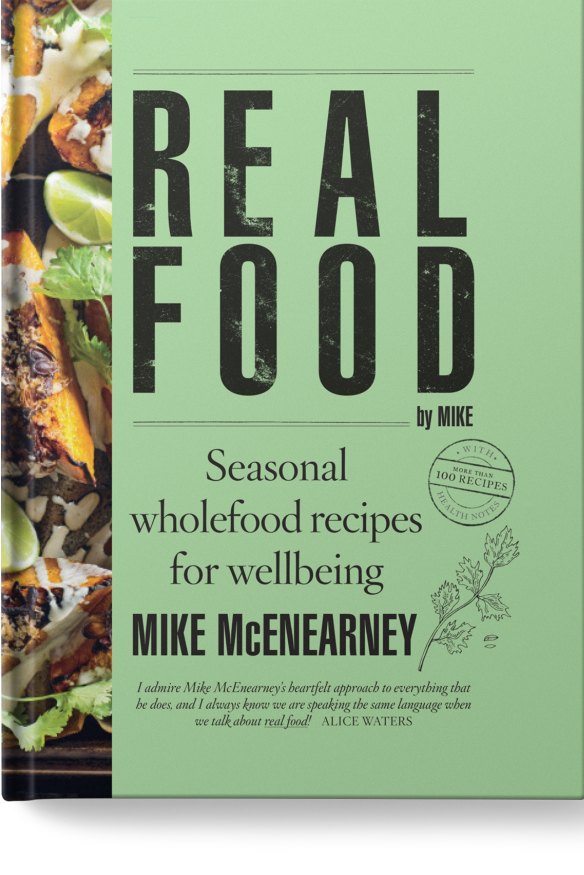
The year 2009 was very big on all fronts in my household. My wife, Joss, and I had been back in Australia for three years and were desperately missing Europe. Joss was also pregnant with our third child, who was due in autumn, and she wanted to be near her family in England.
So when William was born we made the pivotal decision to pack up our life in Australia and fly back to the UK in search of utopia.
One week before our flight, we had a catastrophe. William got very sick. He was only six weeks old and was diagnosed with meningitis. During his time in hospital, it really hit home that there was a lack of fresh nutritional food available to patients. The food consisted of things like dehydrated mashed potato, heavily processed bread, preservative-laden juices and sugared cereals. There was simply no fresh food to heal and nourish – just processed food to poison.
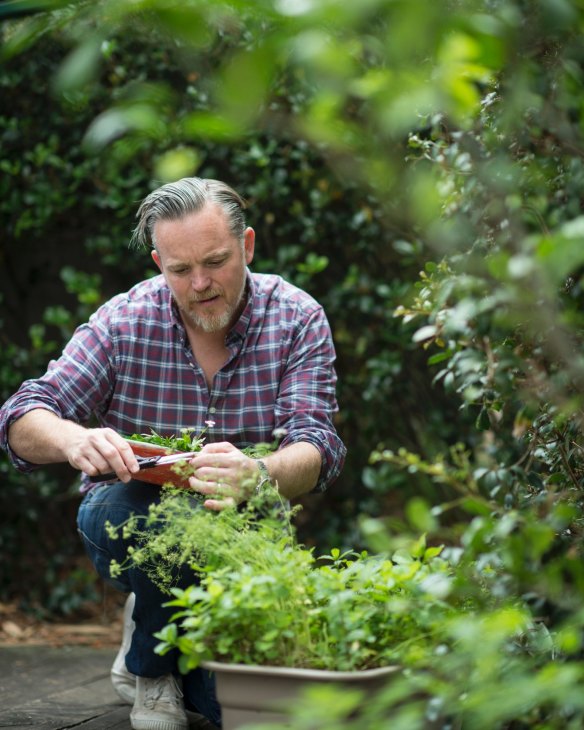
We landed in Britain in July of 2009 to the most glorious summer. The hedgerows were bursting with berries, the sun was shining and life was good. Our aim was to base ourselves at my mother-in-law's small-holding farm in Wales and travel through the UK in short spurts, looking for our new place to call home.
On our travels we saw some beautiful countryside, but what interested us most was life on the farm. Joss's family farm is a truly beautiful property. Some 12 hectares of organic farming land are used to raise specklefaced lambs, Hereford and longhorn cattle and saddleback pigs, and there is one of the oldest apple orchards in Wales as well as a fertile kitchen garden. Joss's family was self-sufficient and a picture of health and happiness. I was hooked and I loved it.
At the time we were at the farm, a local "apothecary" naturopath had also begun to section off four beds in the kitchen garden to create a Hippocratic garden, using the four humours of the body as her guide. Not only were these beds beautiful to look at, they were also stuffed full of medicinal plants and herbs to help relieve medical symptoms. The beds were divided into the humours, or temperaments: sanguine, choleric, melancholic and phlegmatic. It was fascinating to me that she looked at these herbs as medicinal, while I saw them as culinary. From that moment, the phrase "you are what you eat" became truly profound to me.
For the past decade I have noticed the rise in people's interest in good health, and so many fads and diets have been and gone. At Kitchen by Mike, and No. 1 Bent Street, both in Sydney, I have always focused on fresh, seasonal food and, in doing so, have unconsciously endorsed and promoted healthy eating and wellbeing. My interest in health is neither Western nor Eastern. I simply believe in a balanced diet, eating whole foods and all things in moderation. I also believe in using natural medicines to stimulate and assist the body when it's not 100 per cent healthy. I believe that food – and by food I mean all edible flora and fauna in its purest form – is nature's medicine.
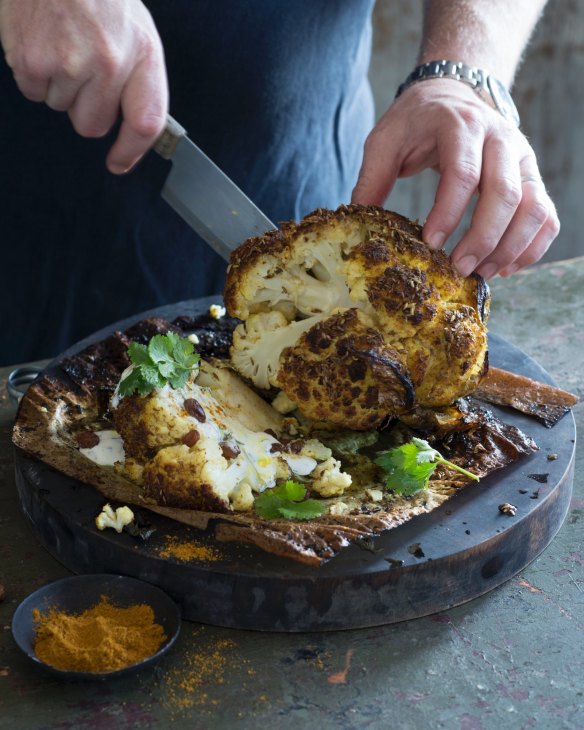
Baked whole cauliflower with Indian spices, mint and yoghurt
Ideally you want to brine your cauliflower overnight, but even a couple of hours in brine will work wonders. Look for a small cauliflower and trim only a couple of the outside leaves as you want as many as possible to help protect the cauliflower while it cooks – plus the leaves make great eating. My Indian spice mix is a personal favourite, but you can choose any spices you like. You'll find many varieties in Asian grocery stores. Try using different yoghurts, too. I love buffalo milk yoghurt for its light texture, and coconut yoghurt works very well if you have dairy allergies. If this is the case you can also replace the clarified butter with olive oil. Additions of sliced fresh chilli to add heat and mint for a menthol hit are great twists.
1 small cauliflower
125 g clarified butter
1 tsp fennel seeds
1 tsp cumin seeds
1 tsp black mustard seeds
2 tbsp Indian spice mix
1 lime, juiced
1 handful coriander leaves, to serve
Saltwater brine
2 litres water
100g sea salt
Raisins in tea
2 tsp Darjeeling tea leaves
500ml boiling water
60g raisins
Yoghurt dressing
1 tsp grated fresh ginger
1 crushed garlic clove
1 handful mint leaves, finely shredded
300g yoghurt
1. For the saltwater brine, combine the salt and water, stirring to fully dissolve the salt. Place the cauliflower in a non-reactive, snug-fitting container with a lid. Pour over the brine to fully submerge the cauliflower and leave in the refrigerator overnight.
2. For the raisins in tea, brew the tea leaves in the boiling water for three minutes. Strain the tea over the raisins in a bowl and allow them to swell for 30 minutes before using. Strain and set aside both tea and raisins until later. (They keep well in the refrigerator until needed. Any type of tea works well, depending on your taste and what you're using the raisins for.)
3. The next day remove the cauliflower from the brine and pat it dry.
4. Preheat the oven to 190C. Line a heavy-based roasting tin with baking paper. Place the cauliflower in the tin, cut side down, so it sits upright. Pour the tea from the raisins over the cauliflower so it hydrates the vegetable and forms a puddle in the tin.
5. Melt the clarified butter in a frying pan over medium heat. When it starts to warm up, add the fennel seeds, cumin seeds and mustard seeds. Cook for one minute until the seeds start to pop in the pan and become aromatic. Brush the clarified butter and seed mixture over the cauliflower and then dust it with the Indian spice mix. Cover the tin with aluminium foil and place it in the oven. Bake for 30 minutes, undisturbed. Remove the foil and baste the cauliflower with the clarified butter and tea liquid sitting in the bottom of the tin. Bake for another 30 minutes, basting regularly with the clarified butter-spice mix.
6. After the cauliflower has been cooking for one hour, insert a skewer or knife into the base. If it's tender, remove it from the oven and rest it in the tin for 15 minutes. If it's not tender, cook it for a few more minutes and check again. Squeeze the lime juice into the baking tin to mingle with the pan juices and create a lovely dressing.
7. For the yoghurt dressing, fold the ginger, garlic, mint and a pinch of salt through the yoghurt.
Serve a wedge of the cauliflower, like a piece of cake, with a few spoonfuls of the pan juice vinaigrette, a dollop of yoghurt dressing, the tea-soaked raisins and a drizzle of oil. Scatter the fresh coriander leaves over to finish.
Serves 4
MEDICINAL BENEFIT: GUT, HEART
Cauliflower is full of phytochemical, and other, compounds that can work to inhibit cancer cell growth. A 100 gram serve of cauliflower gives 80 per cent of the daily recommended intake of vitamin C, a proven agent in the fight against harmful free radicals and infections. Cauliflower also contains good amounts of various B complex vitamins and vitamin K, all required for fat, protein and carbohydrate metabolism. The Indian spices have essential oils that activate both the salivary glands, to aid with digestion, and the glands that secrete bile in the stomach and intestine. Antioxidant essential oils in spices have antimicrobial, anti-inflammatory and anti-stress effects. They're also anticoagulant (i.e. they prevent blood clotting) and carminative, which means they relieve intestinal gas, thereby improving digestion and appetite.
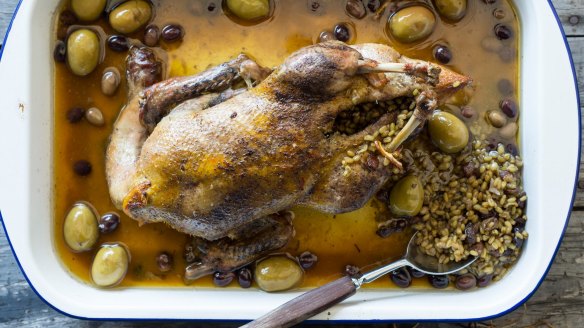
Freekeh-stuffed duck with saffron, olives and preserved lemon
Pot-roasting is a good way to cook a duck. It's gentle enough to keep it moist, which means you can cook it as a whole bird, breast and legs together. Roasting a duck conventionally quite often means the breast is overcooked by the time the legs are done, so this is the perfect solution. Although freekeh is a green wheat, don't be scared. It's a lovely grain that is good for you and it has a nice waxy texture. If you can't find freekeh, use barley or quinoa.
2 pinches saffron threads
2 pinches sea salt
1 red onion, diced
3 garlic cloves, finely chopped
90ml extra virgin olive oil, plus extra to serve
300g freekeh
1 tsp ground allspice
½ tsp ground cinnamon
½ tsp sumac
½ lemon, juiced
1 duck (about 1.9 kg)
200g mixed olives
rocket, to serve
1. Preheat the oven to 100C
2. Place the saffron in a bowl with 125 millilitres of warm water and half the sea salt and set aside to infuse for 30 minutes.
3. Meanwhile, saute the onion and garlic in 60 millilitres of the olive oil with the remaining sea salt over medium heat until tender and translucent, five to six minutes. Add the freekeh and spices and stir to toast for one minute. Remove from the heat, add the lemon juice, season to taste with salt and freshly ground black pepper and set aside to cool.
4. Stuff the freekeh mixture into the duck cavity and leave to stand for about 30 minutes.
Heat the remaining oil in a large flameproof casserole dish or roasting tin over medium–high heat and cook the duck, breast side down, until well browned, 4-5 minutes per breast. Turn the duck onto its back and pour the saffron and its liquid over the breasts. Add the olives to the pan, cover with a lid or aluminium foil and transfer to the oven to braise until the duck is very tender, 2½ hours.
5. When the duck is cooked, rest it for 15 minutes, then drain the pan juices into a jug to use as a gravy, and reserve the olives separately. Carve the duck and serve it with the olives and stuffing spooned out onto the plate. When everyone is nearly finished, serve the rocket to help mop up the juices and cleanse the palate.
Serves 6-8
MEDICINAL BENEFIT: MUSCLES, BONES & JOINTS
Duck is high in omega-6 fatty acid (linoleic acid), which can help stimulate skin and hair growth and maintain bone health. Freekeh is high in protein and also rich in fibre, and foods like this help you feel full for longer. Freekeh also has good quantities of calcium (to build and protect bones), zinc (for the immune system, taste and smell) and iron (for producing haemoglobin in red blood cells, to help transport oxygen throughout the body).
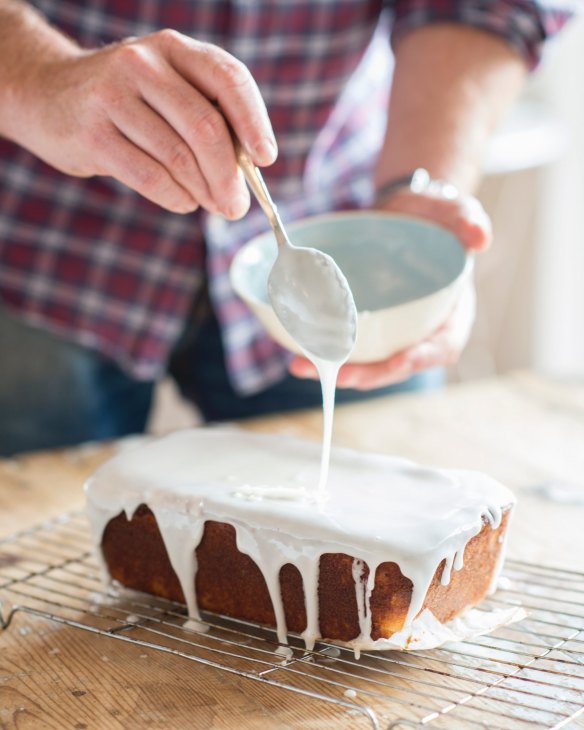
Lemon drizzle cake
I like to use oil in most cake recipes to replace some or all of the butter or lard, especially when I'm baking at home, as I find the cake will keep for longer. (Although with three young boys around, trying to get the cake to 'keep' isn't really an issue.) The oil also ensures a lovely moist texture to the crumb of the cake.
4 eggs
90ml vegetable oil
230g castor sugar
130ml thickened cream
2 lemons, zested and juiced
230g self-raising flour
2 tsp baking powder
Lemon icing
150g icing sugar
1½ tbsp lemon juice
1. Preheat the oven to 190C. Grease and line a 20 centimetre x 28 centimetre loaf tin with baking paper.
2. In a large mixing bowl, either using a wooden spoon or an electric mixer, beat all the ingredients, except the flour and baking powder, until well combined and slightly pale. Fold through the sifted flour and baking powder.
3. Spoon the mixture into the prepared tin and bake for about 45 minutes or until the cake springs back when pressed gently on top. Turn the cake out onto a wire rack to cool.
4. For the lemon icing, sift the icing sugar into a bowl and add two-thirds of the juice, mixing to form a paste. Add as much more juice as you need to make a runny icing. Drizzle the icing over the cooled cake and serve.
Serves 8
MEDICINAL BENEFIT: EAR, NOSE & THROAT
emons are notably high in vitamin C, which boosts the immune system and helps produce collagen, a connective tissue that knits together wounds and supports blood vessel walls. Lemon's flu- and cold-fighting abilities are well documented. They also contain good levels of vitamin A, essential for healthy eyesight, and B complex vitamins for the conversion of food into energy. They're also a good source of potassium to help balance body fluids, maintain a steady heartbeat and lower blood pressure.

Bottled pears
There is much to be said for bottled fruit. The Europeans hold them in high esteem and usually only the finest fruit is kept for this purpose, presented in syrup set in stunning tall jars. When fruit is out of season, this is as close as it gets to eating fruit that still tastes its very best. Any orchard fruit works well, and you can adjust the syrup according to your palate. For a slightly sweeter version, use 60 per cent sugar to 40 per cent water. Or, for a more natural-flavoured syrup, use 40 per cent sugar and 60 per cent water. Syrup choice also depends on the fruit. I find sharper fruit, such as plums and quince, work well in the heavier 60:40 sugar-water syrup while, in this recipe for pears (as well as apples, peaches and nectarines) the standard, medium 50:50 syrup works nicely.
12 ripe pears peeled and cored (or halved if large)
2kg castor sugar
2 litres warm water
1 tsp citric acid
1. Pack the pears into a 3 litre capacity sterilised jar.
2. Combine the sugar, warm water and citric acid in a bowl and stir until the sugar dissolves. Pour the liquid over the pears until they are fully submerged. Secure the jar with a lid, but not too tightly.
3. Place the jar in a large stockpot with enough water to come three-quarters of the way up the jar and bring the pot to the boil over high heat. Reduce the heat to medium and boil gently for 1 hour. Remove the jar from the pan and immediately secure the lid tightly – using a tea towel (dish towel) to help (as it's hot) – to form a vacuum. Leave to cool.
4. Once cool, tap the lid to see if it clicks. This means that the lid has been sucked down by the vacuum and it makes the clicking sound as the metal changes direction. The lid will now look slightly concave instead of convex. If not, give it another 15 minutes in a pot of rapidly boiling water. Unopened, the pears will keep for up to 1 year in the pantry. Once open, your pears will keep for up to 1 month in the refrigerator.
Makes 12 pears
MEDICINAL BENEFIT: GUT, HEART
Pears are among the least allergenic of all fruits; reactions to them are rare. They are full of the antioxidant vitamins A and C (to protect the body), and minerals such as copper, potassium, manganese and magnesium, which may help stabilise blood pressure. Pears are also a good source of insoluble fibre, which acts as a mild laxative. It's believed it could help protect against cancer-causing toxins by binding to them in the colon.
This is an edited extract from Real Food By Mike by Mike McEnearney, published by Hardie Grant Books, RRP $45.
Appears in these collections
The best recipes from Australia's leading chefs straight to your inbox.
Sign up